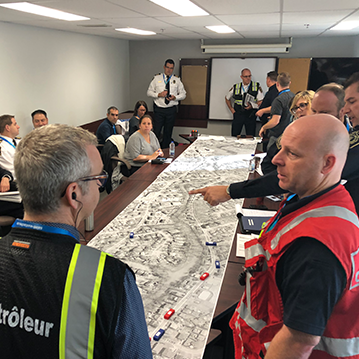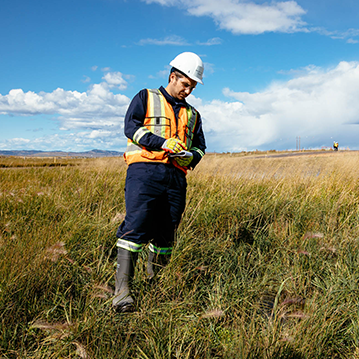Emergency Management

We expect the companies we regulate to do everything they can to keep things safe, which includes being ready in case of an emergency. In an emergency, we make sure companies respond in a way that protects people, property, and the environment. We expect them to take the action needed to stop spills, manage an incident, and clean up and pay for any damage done.
What you need to know
Find out who you should call in case you witness an energy emergency.
Preparing for an emergency – What we expect of companies
Discover how we expect companies to prepare for emergencies by developing programs that include consultation, education, and training.
Find detailed information about emergency management by reading through some of our relevant regulatory documents.
Learn about how the CER plays an important role in the response to an emergency by working with the company in addition to local and provincial responders.
Who pays for the cost of an incident?
Learn how the CER requires companies to pay for the costs of responding to an emergency.
See how we make sure companies follow regulations, address issues before they become a problem, and prevent them from happening again.
Read reports that document how well companies are doing with their emergency management activities.
What we are doing
Managing emergencies
Holding companies accountable
Our response
Report an incident

Call one of the numbers below to report an incident.
- Call the Transportation Safety Board for pipeline emergencies:
- 1-819-997-7887 (24-hour hotline)
- Call the CER for emergencies with operations, a facility, or an activity:
- 403-299-2773
- Call the Spill Report Line for spills from an exploration or production facility under the Canada Oil and Gas Operations Act or the Canadian Energy Regulator Act in the Northwest Territories, Nunavut, or Canadian Arctic Waters.
- 1-867-920-8130
Regardless of what line you call, we’ll be notified. The Transportation Safety Board and the Spill Report Line notifies us of any incident called in to them on a facility or pipeline we regulate.
How does the public get notified of an incident?...
Any individuals or communities affected by an emergency on a facility or a pipeline we regulate should be alerted by the company’s response operations immediately.
They could be alerted by:
- phone call
- door knocking
- public service alert
- social media posting
Companies are required to know which communities and individuals could be affected in an emergency on a facility or pipeline we regulate and have plans in place for how to notify them. We’ll look for this information in the emergency procedures manual companies submit to us and when we check to see if a company is meeting our requirements.
Preparing for an emergency – What we expect of companies
Companies need processes in place to identify, manage, and mitigate risks. They also need to tell us how they plan to manage an emergency and how they’ll protect property, the environment, workers, and the public. When they apply to us, they must submit this information so we can verify it’s complete and that it will be reviewed and updated regularly.
When developing an emergency management program it’s important that companies:
- Consult: When companies start to plan a project, they must speak with everyone who needs to know of an emergency. We expect them to build relationships with everyone needed during an emergency.
- Educate: A continuing education program must be in place for police, fire departments, medical facilities, and other organizations and agencies and the public living nearby.
- Train: Develop training and exercise programs for employees who need to respond to an incident.
Read a summary of some of the key points we need companies to understand in CER Expectations for Emergency Procedures Manuals.
Regulations and guidance
Onshore Pipeline Regulations...
A company’s processes for managing an emergency must meet the requirements in the Onshore Pipeline Regulations (OPR). Under these regulations, companies must have an emergency management program.
Canada Oil and Gas Drilling and Production Regulations...
If a company’s operations fall under the Canada Oil and Gas Operations Act, then the process for responding to emergencies must meet the requirements of the Canada Oil and Gas Drilling and Production Regulations.
Guidance Notes for the Onshore Pipeline Regulations...
The contents of an emergency procedures manual required under the Onshore Pipeline Regulations (OPR) should include the information under number 2 of Annex A: Further Information for the Emergency Management Program in the Guidance Notes for the Onshore Pipeline Regulations.
CER Filing Manual...
The CER Filing Manual guides companies on the emergency response information they need to have and what needs to be in an emergency procedures manual when they apply.
CER Event Reporting Guidelines...
Companies must report events, such as incidents, and their emergency programs must contain the right processes for doing so. The CER Event Reporting Guidelines assists companies in knowing what and how to report this information. Learn more about event reporting at the CER and the Event Reporting Guidelines.
Letter and order compelling submission of emergency response procedures...
This letter on emergency procedures manuals advises companies how we are to receive an emergency procedures manual and when we must receive updates. It also restates what the contents of a manual should contain. Read the letter and order.
Letter and Order AO-001-MO-006-2016 which Varies Order MO-006-2016 – Compelling Publication of Emergency Procedures Manuals...
These orders [Filing A79720] require companies to post their emergency procedures manuals on their website for the public.
Letter and Order AO-001-MO-002-2017 which Varies Order MO-002-2017 – Compelling Publication of Emergency Management Program Information on Company websites...
This order on emergency management programs requires companies to publish their management system for addressing emergencies on their webpages. Read the order in REGDOCS [Filing A81701].
- Industry Best Practices for Notifications to Indigenous Nations and Communities regarding CER-reportable Incidents
- Industry Best Practices for Involvement of Indigenous Nations and Communities in Emergency Management
- Frame of Reference –Pipeline Response – Letter to All Oil and Gas Pipeline Companies under the Jurisdiction of the Canada Energy Regulator (CER) and operating in Québec
Pipeline Performance Measures...
Section III: Emergency Management Performance Measures contains information and guidance on performance measures for emergency management. Performance measures are necessary part of the management systems we expect companies to have in place for anticipating, preventing, managing, and mitigating issues.
CER emergency response
We oversee a company’s response during an emergency to make sure people, property, and the environment are protected. We assist the company responsible for the incident and any municipal or provincial responders.
- Pamphlet: Responding to Emergencies
What if a company isn’t responding to an incident?...
In the unlikely event that a company is unable to respond effectively to an incident, we will assume control of the response.
How does the CER support Natural Resources Canada during an incident?...
The CER is the lead federal regulatory agency for all incidents on a facility or pipeline we regulate. However, we may work with Natural Resources Canada to respond to energy-related emergencies at a national level.
How does the CER ensure its own continued operation as a federal agency?...
The federal government needs to be able to continue to operate effectively during a national or regional emergency. This helps us ensure public safety, continue critical services, and maintain uninterrupted direction and control. To help with this, Public Safety Canada created the Federal Emergency Response Plan. This plan organizes all federal response plans. These plans ensure emergency response processes are delivered and carried out in an effective, coordinated, and efficient manner in a national emergency.
- Learn more about emergency management and the federal government on Public Safety Canada’s website
- An Emergency Management Framework for Canada
Who pays for the cost of an incident?
Companies we regulate are responsible for all costs of an incident. We have the authority to order a company to pay others that have incurred costs or expenses because of an incident.
Compliance and enforcement
We check to make sure companies are meeting our requirements, from when a company first applies to when a project ends. This may mean us asking for more information or doing an inspection or an audit. For companies that aren’t meeting our standards and requirements, we’ll take steps to enforce them and bring the company back into compliance.
Learn more about how we verify compliance and enforce our requirements.
Stay informed

We share the work we do to check that companies are meeting our requirements, to find issues before they become a problem, and how we are helping prevent them from happening again.
Most of the work we do is work to make sure companies are ready to respond. As a result, we regularly go out into the field to evaluate a company’s preparation and to ensure requirements are being met. We post records of work we’ve done as compliance verification activity reports.
Features
Emergency response
Safety culture
News and updates
- Date modified:



